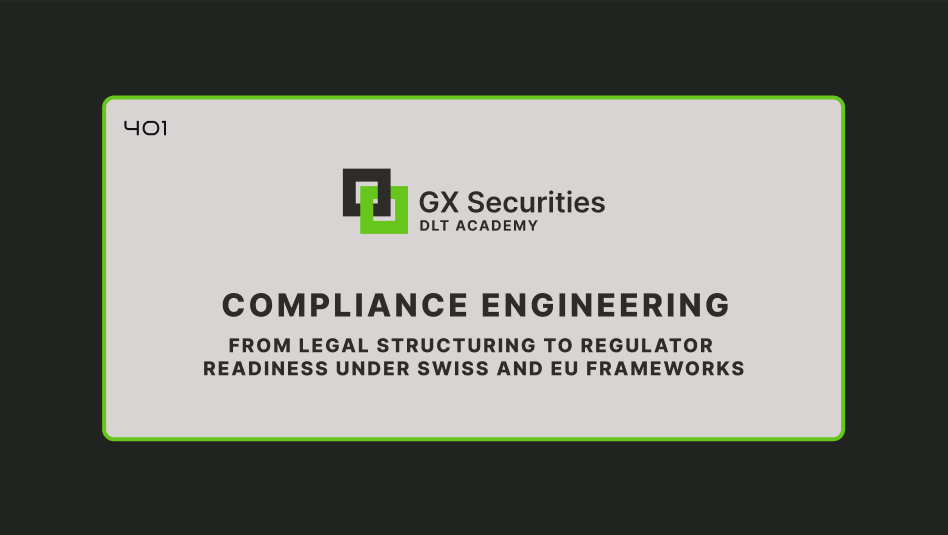
As digital securities transition from pilot programs to fully regulated financial instruments, regulatory alignment is no longer optional, it is foundational. For institutions operating in Switzerland and the European Union, legal compliance is defined by a complex intersection of financial market law, distributed ledger legislation and cross-border securities directives.
This faculty is designed to equip legal counsel, structuring teams,and compliance officers with the technical understanding and practical tools needed to operate under Switzerland’s FinSA, FinMIA and the DLT Act, as well as the European Union’s Markets in Crypto-Assets Regulation (MiCA) and MiFID II. Participants will gain the ability to map asset structures to legal classifications, prepare regulator-ready documentation and implement compliant token issuance and trading strategies.
By completing this faculty, participants will be able to:
Core legal frameworks and classifications
Understanding foundational regulation for institutional tokenization in Switzerland and the European Union
DLT-based financial products must align with the same legal requirements that govern traditional securities—only with additional considerations for technological neutrality, cross-jurisdictional enforceability and on-chain compliance. Legal structuring is not a post-launch consideration; it is a precondition for issuance, secondary trading, investor protection and regulatory acceptance.
Whether launching a revenue-sharing token, a fund participation instrument, or a decentralized trading venue, institutions must begin with the right legal frameworks. This module introduces the statutory pillars that define how tokenized assets are classified, regulated and licensed across key European jurisdictions.
Financial Services Act (FinSA)
FinSA governs investor protection and disclosure obligations. It defines when a prospectus is required, how financial instruments are classified, and what investor segmentation applies.
Financial Market Infrastructure Act (FinMIA)
FinMIA regulates the trading of financial instruments and the operation of market infrastructures.
Swiss DLT Act (2021)
The DLT Act amended both FinSA and FinMIA, introducing uncertificated register securities under Article 973d of the Swiss Code of Obligations.
GXFlex and other GX-issued tokens are structured under Art. 973d CO, offering full legal enforceability as DLT-based securities while integrating with XRPL infrastructure.
Markets in Crypto-Assets Regulation (MiCA)
MiCA is the EU’s foundational regulation for unregulated crypto-assets and stablecoins. It comes into effect progressively through 2024–2025.
MiCA does not apply to financial instruments under MiFID II. Instead, it creates a separate licensing framework for:
MiCA introduces:
Markets in Financial Instruments Directive (MiFID II)
If a digital asset qualifies as a financial instrument (e.g., security token, derivative, unit in a fund), it is regulated under MiFID II.
Institutional security tokens like GXFlex, ALTVolt and DLT256 must be structured to meet MiFID II classification tests if distributed to EU investors.
The classification of a tokenized asset depends on its legal structure, investor rights and economic function—not the blockchain or smart contract it uses.
Digital Security | Art. 973d CO / MiFID IIProspectus or exemption under FinSA or EU Prospectus Reg.
Utility Token | MiCA (if not a financial instrument)Whitepaper & issuer registration
Stablecoin | MiCA – ART or EMTCentral bank or EBA supervision
Cryptocurrency | Outside financial regulation
Institutions must conduct a classification analysis prior to issuance, ensuring investor documentation, rights assignment and token infrastructure align with the selected legal pathway.
Continue to: Module 4.2 – Article 73a–73f FinMIA Deep Dive
Explore how to structure, license, or exempt a DLT trading venue under Swiss law and how GX Securities approaches its licensing path.
Recommended: Module 4.3 – Prospectus Writing & Legal Disclosure
Learn how to draft and validate token prospectuses under FinSA and MiCA and apply Art. 36 exemptions with legal precision.
Discover how GX Securities leverages the XRP Ledger for compliant DeFi infrastructure and tokenized asset operations visit www.gxsecurities.com | Institutional DeFi on XRPL | GX Securities Blog
Contact us at compliance@gxsecurities.com or send us an inquiry
Disclaimer: GX Securities operates solely as a DLT infrastructure provider and this article does not constitute financial advice or an offer of securities.
By entering, you confirm that you are an institutional or professional investor eligible under applicable regulations. Retail investors are not permitted. If you are not eligible, please exit.
GX Securities is a DLT infrastructure provider and does not offer investment services, advice or custody. DLT securities content is informational only and not an offer or solicitation.
I acknowledge and agree to the
Terms of Use
Privacy Policy